Related Research Articles
Bicyclus aurivillii is a butterfly in the family Nymphalidae. It is found in the Democratic Republic of the Congo, Uganda, Rwanda and Burundi.

Acraea aurivillii, the large alciope acraea, is a butterfly in the family Nymphalidae. It is found in Sierra Leone, Liberia, Ivory Coast, Ghana, Nigeria, Cameroon, Gabon, the Republic of the Congo, the Central African Republic, the Democratic Republic of the Congo, Burundi, Uganda, Kenya, Tanzania, Zambia and Ethiopia. The habitat consists of forests.
Cymothoe aurivillii is a butterfly in the family Nymphalidae. It is found in Tanzania. The habitat consists of sub-montane and montane forests.
Neptis aurivillii is a butterfly in the family Nymphalidae. It is found in Kenya, Tanzania, Malawi and Zambia. The habitat consists of montane and sub-montane forests.
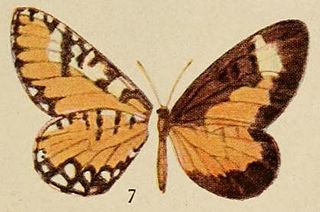
Telipna aurivillii is a butterfly in the family Lycaenidae. It is found in the Democratic Republic of the Congo and Uganda.
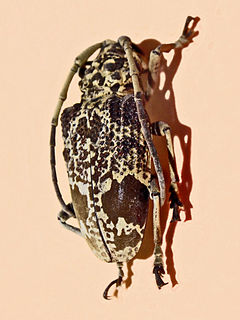
Phryneta is a genus of flat-faced longhorn beetles belonging to the family Cerambycidae.

Phrynetini is a tribe of longhorn beetles of the subfamily Lamiinae. It was described by Thomson in 1864.
Phiala aurivillii is a moth in the family Eupterotidae. It was described by George Thomas Bethune-Baker in 1915. It is found in Zambia.

The Castilloa Borer is a species of beetle in the family Cerambycidae. It was described by Johan Christian Fabricius in 1775, originally under the genus Lamia. It has a wide distribution throughout Africa. It feeds on Morus alba, Hevea brasiliensis, Coffea arabica, and Chlorophora excelsa.

Phryneta macularis is a species of beetle in the family Cerambycidae. It was described by Harold in 1879. It is known from the Democratic Republic of the Congo and Angola.
Phryneta atricornis is a species of beetle in the family Cerambycidae. It was described by Léon Fairmaire in 1893. It is known from Comoros.

Phryneta aurocincta is a species of beetle in the family Cerambycidae. It was described by Félix Édouard Guérin-Méneville in 1832, originally under the genus Lamia. It has a wide distribution throughout Africa.
Phryneta coeca is a species of beetle in the family Cerambycidae. It was described by Chevrolat in 1857. It is known from Tanzania, the Central African Republic, the Ivory Coast, Cameroon, the Democratic Republic of the Congo, and Togo.
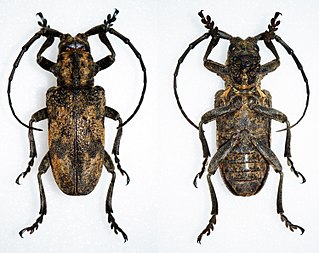
Phryneta obesa is a species of beetle in the family Cerambycidae. It was described by Westwood in 1845. It has a wide distribution in Africa.
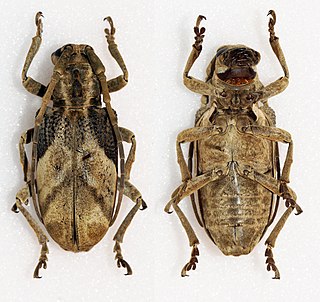
Phryneta semirasa is a species of beetle in the family Cerambycidae. It was described by Dohrn in 1885. It is known from Tanzania, the Democratic Republic of the Congo, Mozambique, Zimbabwe, Malawi, and Zambia.
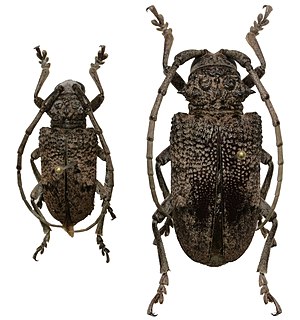
The Fig-tree Borer Longhorn Beetle, or Fig Tree Borer, is a species of beetle in the family Cerambycidae. It was described by Johan Christian Fabricius in 1792, originally under the genus Lamia. It has a wide distribution throughout Africa. It feeds on Pyrus communis, Ficus carica, Salix babylonica, Cupressus sempervirens, and Vitis vinifera.

Phryneta verrucosa is a species of beetle in the family Cerambycidae. It was described by Dru Drury in 1773, originally under the genus Cerambyx. It is known from Equatorial Guinea, and was introduced into Barbados, Grenada, and Trinidad and Tobago.
Glenea aurivillii is a species of beetle in the family Cerambycidae. It was described by Warren Samuel Fisher in 1935. It is known from Borneo.
Notapictinus aurivillii, the piesmatids, is a species of flat bug in the family Aradidae. It is found in North America.
Ephemerella aurivillii is a species of spiny crawler mayfly in the family Ephemerellidae. It is found in Europe and Northern Asia, North America. In North America its range includes all of Canada, the northern, southwestern United States, and Alaska.
References
- ↑ BioLib.cz - Phryneta aurivillii. Retrieved on 8 September 2014.